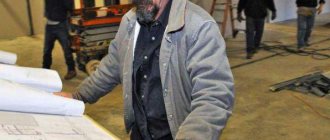Home — Administrative law — Responsibilities of a specialist in finishing works of a building
It is often more profitable for employers to hire multidisciplinary specialists with a wide range of skills and experience working with different types of materials, premises and tools than narrow specialists in one field - tilers, drywallers, painters, plasterers. The fact is that universal masters are interchangeable and can easily move to another area of work, for example, under force majeure circumstances or simply wanting to change the type of load, which helps to avoid a significant drop in efficiency when physical fatigue sets in. Such craftsmen are especially in demand at small or medium-sized repair enterprises or teams, as well as among private customers. But this does not mean that having a limited specialization, and being, for example, a painter or drywaller, you will not be able to find a job.
Job description for a master of finishing construction works
- A basic level of education and short-term professional courses are quite enough to start working in your specialty;
- Employers value skills rather than formal work experience, which opens up wide employment opportunities for young professionals;
- Having realized yourself as a qualified and experienced specialist, you can rise to the rank of senior foreman, foreman, think about creating your own business or private team, working as an individual entrepreneur, and also engage in teaching activities in training centers for construction and repair specialists.
Disadvantages and contraindications for the profession of a finisher Like any profession, working as a finisher also has disadvantages that must be taken into account when making your professional choice.
Employee rights
It is worth paying attention to the employee's credentials. The specialist in question has a number of legal rights that he can exercise during the exercise of his professional activities. Here's what you should pay attention to here:
- Familiarization with the documentation necessary for the work, signing it.
- Submission of proposals for possible modernization of the organization’s activities, improvement of construction technology, etc. for consideration by the management team.
- Suspension of work activities in the event of equipment malfunctions.
- Stopping work in the event of detection or receipt of low-quality material, improper structures, etc. It is the responsibility of the foreman to immediately inform the site manager about this.
It is also worth noting that the master has a wide range of rights in relation to his subordinates. Thus, he can make proposals for material incentives for members of the workforce at the site.
Profession of a finisher: features, pros and cons
Important
I approve [position, signature, full name of the manager or other official authorized to approve the job description] [date, month, year] M.P. Job description of the master of finishing construction works [name of organization, enterprise] This job description has been developed and approved in accordance with the provisions of the Labor Code of the Russian Federation, the All-Russian Classifier of Primary Vocational Education OK 023-95 (adopted and put into effect by Decree of the State Standard of the Russian Federation of December 27, 1995 N 639) and other legal acts regulating labor relations.
1. General provisions 1.1. The master of finishing construction works belongs to the category of skilled workers and is directly subordinate to [name of the manager's position]. 1.2.
II. Job responsibilities
The responsibilities of a construction and installation foreman include:
1. Preparing the site for the same type of construction work:
— Coordination of volumes of production tasks for the production of similar construction works
— Coordination of calendar plans for the production of similar construction works
— Preparation of the site for the production of similar construction works and workplaces in accordance with the requirements of labor protection, fire safety and environmental protection
— Equipment of a site for the production of similar construction works
— Instructing employees on labor protection and fire safety requirements
— Monitoring compliance with labor protection, fire safety and environmental protection requirements
— Preparation of workplaces for a special assessment of working conditions
2. Logistics and technical support for the production of similar construction works:
— Determination of the need for material and technical resources for the production of the same type of construction work
— Control of the quality and volume (quantity) of material and technical resources for the production of the same type of construction work
— Application, acceptance, distribution, accounting and storage of material and technical resources for the production of the same type of construction work
3. Operational management of the production of similar construction works:
— Operational planning and control of the execution of similar construction works
— Distribution of production tasks between teams, units and individual workers
— Monitoring compliance with the production technology of the same type of construction work
— Development, planning and control of the implementation of operational measures aimed at correcting defects in the results of similar construction works
— Maintaining current and as-built documentation for the types of similar construction work performed
4. Quality control of production of similar construction works:
— Operational control of individual construction processes and (or) production operations during the production of the same type of construction work
— Current quality control of the results of similar construction works
— Identification of the reasons for deviations of the results of construction work from the requirements of regulatory, technological and design documentation
— Development, planning and monitoring of the implementation of measures aimed at preventing and eliminating the causes of deviations in the results of completed similar construction work from the requirements of regulatory technical, technological and design documentation
5. Increasing the efficiency of production and economic activities of the site where similar construction works are carried out:
— Assessing the efficiency of production and economic activities of a site of the same type of construction work
— Optimization of the use of material and technical resources in the production of similar construction works
— Increasing the level of mechanization and automation of similar construction works
— Rationalization of labor methods and techniques in the production of similar construction work
6. Management of workers at the site where similar construction works are carried out:
— Determination of the need for labor resources for the production of the same type of construction work
— Arrangement of workers at the site for the production of the same type of construction work in workplaces, formation of teams and units
— Distribution and control of employees’ performance of production tasks and individual works
— Monitoring compliance by employees of the construction site of the same type of construction work with internal labor regulations
— Improving the professional qualifications of workers in the area where similar construction works are carried out
— Preparation of proposals for incentive and penalty measures
Mo
Info
A construction finisher must know the features of placement and rules for preparing surfaces for painting, plastering and facing work. Also, a construction finisher must know the rules for cutting and pasting surfaces with wallpaper and other appropriate artificial materials. A construction finisher must know how to perform painting, plastering and tiling work, and the requirements for the quality of work performed.
A construction finisher must know the safety rules when using mechanized electrified tools (equipment). A construction finisher must know fire safety rules and sanitary standards. Rights of a construction finisher: A construction finisher has the right to demand proper working conditions and provision of the necessary tools and equipment.
What does the employee do?
The main responsibility of the construction and installation work foreman in construction is to monitor the implementation of the approved production plan by builders, as well as to take measures to ensure that the deadlines specified in the plan are not delayed. Moreover, the employee also ensures that workers comply with current construction technologies and do not violate them. If violations of the technology are discovered in the future, then it is the master who will bear responsibility as the one who committed the violations.
In essence, he is the controller and immediate supervisor of the work taking place on the site. In the process of implementing the production plan, he monitors the correctness of the work, makes appropriate measurements, transfers samples to the construction laboratory to determine the quality of the work, enters data into the documentation, makes notes in production plans and other documents. He also directly supervises the actions of the builders, telling them what needs to be done on a particular day or what the next step will be taken in construction.
Jobs as a finishing specialist in Moscow: 52 vacancies
Improve your qualifications in accordance with the procedure established by law. 3.5. For all social guarantees provided for by law. 3.6. Other rights provided for by labor legislation. 4. Responsibility of the employee The master of finishing construction works is responsible for: 4.1. For failure to perform or improper performance of their job duties provided for in this job description - within the limits determined by the current labor legislation of the Russian Federation. 4.2. For causing material damage to the employer - within the limits determined by the current labor and civil legislation of the Russian Federation; 4.3. For offenses committed in the course of carrying out their activities - within the limits determined by the current administrative, criminal, and civil legislation of the Russian Federation. Head of Human Resources (initials, surname) (signature) » » 20
I. General provisions
1. A person who has a secondary vocational education under the training program for mid-level specialists (“Architecture and Construction”) or secondary vocational education (non-core) and additional vocational education under a professional retraining program in the field of professional activity is appointed to the position of construction and installation work foreman.
2. Work experience of at least one year in the profile of professional activity in the field of construction and installation work.
3. Appointment to the position of construction and installation work foreman, as well as dismissal from it, is made by order of the head of the organization.
4. The construction and installation work master must know:
4.1. Requirements of regulatory technical documents for the performance of similar construction works
4.2. Principles of organizing complex and specialized production units and teams
4.3. Technologies for the production of similar construction works
4.4. The procedure for developing and coordinating production tasks and plans for the production of similar construction work (operational plans, plans for resource requirements, schedules)
4.5. Methods for calculating the labor, material and technical resources necessary to fulfill the volumes provided for by production tasks and calendar plans for the production of similar construction work
4.6. Requirements of technical documents defining the composition and procedure for arrangement of a construction site (on-site preparatory work)
4.7. Types and technical characteristics of technological equipment (scaffolding, scaffolding, protective devices, fastening the walls of pits and trenches)
4.8. Requirements of regulatory documents in the field of labor protection, fire safety and environmental protection
4.9. Types of negative impacts on the environment during various types of construction work and methods for their minimization and prevention
4.10. Main harmful and (or) dangerous production factors
4.11. Labor protection and fire safety requirements for similar construction work
4.13. Requirements for workplaces and the procedure for organizing and conducting a special assessment of working conditions
4.14. Rules for maintaining documentation for monitoring compliance with labor protection, fire safety and environmental protection requirements
4.15. Administrative and criminal liability measures applied in case of violation of labor protection, fire safety and environmental protection requirements
4.16. Regulatory requirements for the production of similar construction work in material and technical resources
4.17. Types and properties of basic building materials, products and structures
4.18. Types and characteristics of basic construction equipment and tools
4.19. Types and characteristics of construction machines, power plants, vehicles
4.20. Rules for transportation, warehousing and storage of various types of materials and components
4.21. Rules for the maintenance and operation of machinery and equipment
4.22. The procedure for drawing up reporting documentation (statement of consumption of construction materials) on the use of material assets
4.23. Requirements of technical documents and design documentation for the procedure and technology for carrying out similar construction work
4.24. Requirements for structural elements of a building (premises) and common property of multi-apartment residential buildings, due to the need for their accessibility and compliance with the special needs of people with disabilities
4.25. Methods of operational planning for the production of similar construction works
4.26. Methods for determining the types, complexity and volumes of similar construction work and production tasks
4.27. Rules for maintaining executive and accounting documentation during construction work
4.28. Operational quality control schemes
4.29. Methods and means of instrumental quality control of the results of similar construction works
4.30. Rules for documenting the results of construction quality control, provided for by the current standards for the acceptance of construction work
4.31. Methods, means of detecting and promptly eliminating deficiencies and defects in the results of similar construction work (the use of alternative work methods, tools, materials and components)
4.32. Methods for calculating the main indicators of the efficiency of production and economic activities
4.33. Criteria for assessing the efficiency of production and economic activities
4.34. The main factors for increasing the efficiency of production of the same type of construction work
4.35. Regulatory requirements for the number and professional qualifications of workers at the site of similar construction work
4.36. Basic requirements of the labor legislation of the Russian Federation, rights and obligations of employees
4.37. Basic principles and methods of workforce management
4.38. Internal labor regulations, job descriptions
4.39. Methods for carrying out standard control of the implementation of production tasks and individual works
4.40. Basic forms of organizing vocational training in the workplace
4.41. Basic measures to encourage employees, types of disciplinary sanctions
4.42. _____________________________________________________________________
5. The foreman of construction and installation works reports directly to __________________.
6. During the absence of a construction and installation foreman (vacation, illness, etc.), his duties are performed by a person appointed in the prescribed manner. This person acquires the corresponding rights and is responsible for their proper execution.
7. ________________________________________________________________
Error 404 page does not exist
For example, this type of work is not recommended for people with poor health, asthma and respiratory diseases, hernias, back and spinal injuries that do not allow constant physical activity. The disadvantages of the profession include:
- Quite harmful working conditions - you have to work with dirty and dusty materials, chemicals and harmful fumes, so you should never forget about protecting your face, eyes and respiratory tract with special masks;
- There is a certain seasonality in the work of a finisher - in winter the number of orders may decrease, which means that during this period income may also decrease.
Job for a finisher
The construction finisher also carries out work using modern technologies, materials and technical means. The construction finisher controls the quality of the work performed using appropriate instrumentation and tools. A construction finisher adjusts and eliminates minor malfunctions in mechanized, electrified and other tools (equipment) that he uses in the process of performing the specified work (operations). A construction finisher must know: A construction finisher must know the types, range and technological properties of materials used in painting, plastering and facing work. A construction finisher must know the recipes and rules for preparing paints, varnishes, mastics, putties, putties, glue, special and decorative solutions, mixtures, etc. Finisher or finishing work master is the general name of a group of professions associated with the finishing stage of repairing walls and ceilings of residential or commercial premises - plastering, painting, paint and varnish and tiling works, finishing with plasterboard and other materials. This category includes specialists in the following profiles:
- plasterer
- painter
- painter-plasterer
- finisher
- drywaller
- tiler
- flooring installer
- specialist in texture and decorative plaster, etc.
Skills and specifics of the work of finishing craftsmen In essence, a finishing craftsman is a generalist who must master various skills and technologies in the field of repair work in order to be a sought-after specialist in the labor market. However, many types of work do not have temperature restrictions, so it is still not worth talking about the absoluteness of the seasonal factor;
- At the height of the season, on the contrary, there may be a large influx of orders and a busy intensive work schedule, which can lead to overload, increased fatigue and exhaustion of the body. It is recommended not to overload yourself with work, not to give up days off and not to try to work more than 10 hours a day;
- Heavy physical activity, prolonged standing on your feet or in an uncomfortable position (the cervical-vertebral region suffers when finishing ceilings), the need to carry heavy objects.
Construction schedules
It’s worth talking in a little more detail about exactly how a construction and installation master should plan his work. The source document for planning is the directive schedule - an approved plan on the basis of which other calendar plans should be drawn up. The drawn up schedules must cover all work related to the work of the foreman: repair, installation, construction, liquidation, etc.
The construction schedule must indicate the deadlines for completing the work in relation to special and general work. When forming a document, it is necessary to take into account the features of the facility being built, the timing of receipt of materials, the movement of workers, etc.
Responsibilities of a building finishing specialist
Attention
A construction finisher carries out protective coating of the surface with special solutions, liquids, and mixtures. A construction finisher makes stencils, combs, etc. for applying drawings to the surface, restores and performs decorative coating of the surface. A construction finisher performs work on plastering surfaces, repairing plaster, plastering surfaces with decorative solutions and special-purpose solutions.
The construction finisher also covers the surface with wallpaper and other artificial coverings and performs finishing work. A construction finisher performs work on cladding, decorative cladding, repair, replacement, and dismantling of various assortments of tiles. A construction finisher prepares paint compositions, colors, glue, plaster, special solutions, etc.










